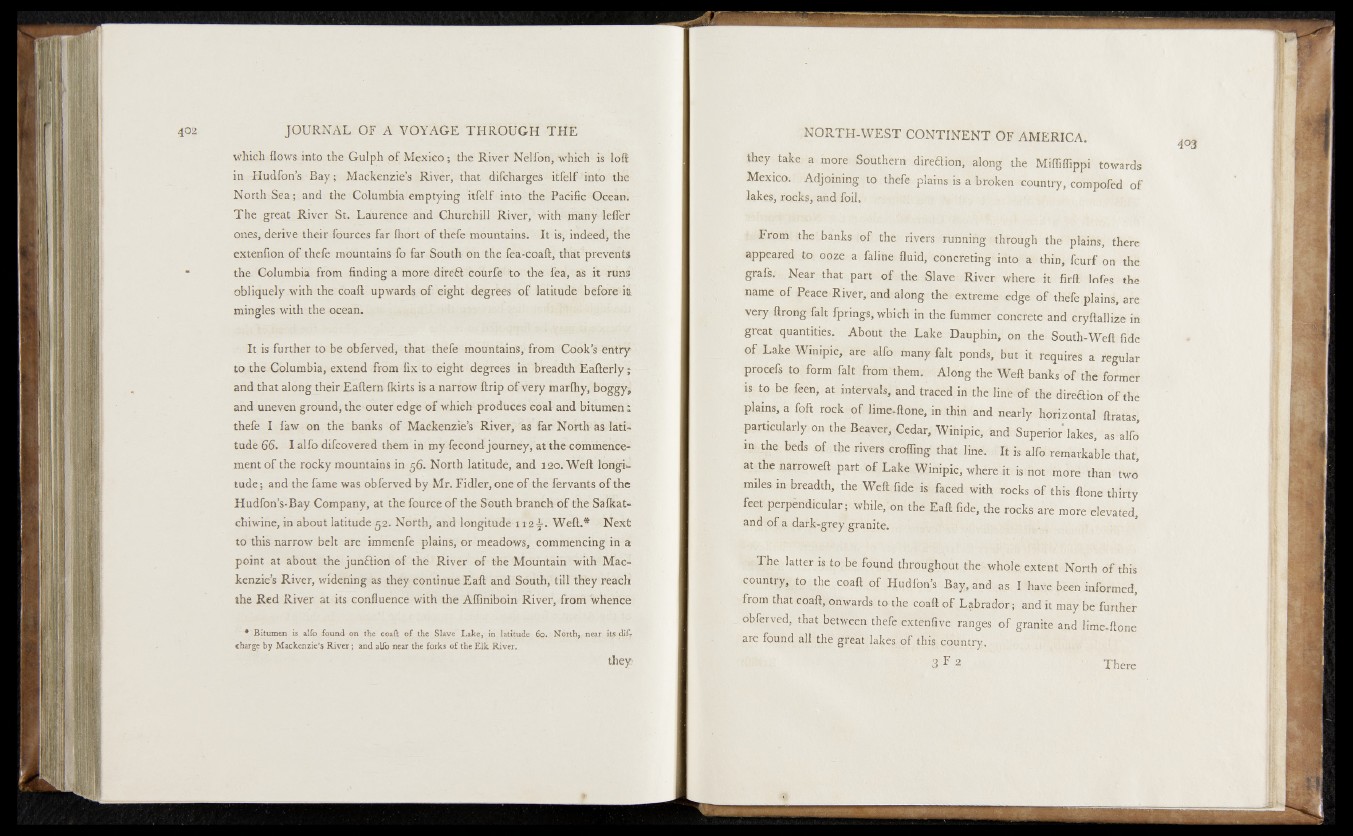
Which flows.-mto the Gulph of Mexico ; the' River Nelfbrq which' is loft
in . Hudfon’s Bay.; Mackenzie’s River, that difcharges ftfelf ’ittio the
NorthiSsa;; and, the Columbia emptying RaSific* Ocenri«
The great River St. Laurence aod-ChurChill River, v^ith ibany- le®r
ones:,, derive. their fources far fhort of thefe-mbuntaihs.: ' It is, indee€fttib
extenfion ofttbefe mountains fo far South on the fea-coaft, ^tepre^siisi
the Columbia from finding a more dne& courfe'to the lea, a& it runs'
obliquely with the coaft upwards of eight degrees of latitude • beforeit.
mingles with the ocean.
It is further to be oblerved, that- thefe mountains,* from-. 'Cbok’s bntry
to the Columbia, extend from fix to eight degrees in 'breadth Eafterl-yV
and that along their Eaftern Ikirts is a narrow ftrip of very marffiyibbggyj
and uneven ground, the outer edge o f which produces coal and bitumen i
thefe I law on the banks o f Mackenzie s River, as for Nor-tK as latitude
66. I alio difco.vered them in my fecond journey, at the commencement
of the rocky mountains in 56. North latitude, and 120. Weft lotigi-
tude; and the fame was oblerved by Mr. FidleE, one of. the fervants of the
Hudfon’s-Bay Company, at the fource o f the South branch bf the Safttat-
chiwine, in about latitude 52. North, and longitudeilhy.We-ft.* Next
to this narrow belt are immenfe plains, or meadows, commencing in a
point at about thejunftion of the River of the Mountain with Mackenzie’s
River, widening as they continue Eaft and South, till tHfey reach
the Red River at its confluence with the Affiniboin- River, from whence
• Bitumen is aUb found on the coaft of the Slave Lake, in latitude @q. Nött^nevr, itß ftifr
charge by Mackenzie'» River; and alfo near the forks of theElk River..
they
fhey take, a more Southern ..direHion, along, the Miffiffippi towards
Mexico»: - Adjoining to thefe plains is ^broken country, compofed of
lakes, fQfiks, and -foil. *
- From 'the^banks loft th^ Tver’s i;ruhifi%^thhDugh the plains, there
appeared to, odze a- faUhe fluidi'^ceinoietmg'Miltdfa thini'fcurf on the
grafs.lrNe.qr that,paffc o f' the, «Slayer River where-; >it1 firlftToles the
name o f $eaee-River, and-afong-the* extedm®,edgo ofthdfe.plains,’are
very.'ftrongf!£lt fprings, which imtHe firmrtfer 'concteto andeifftallke in
great- quantities^, About? the. Lake Dauphin,'on the* South*-Weft:
o f -Lake-Winipic, are alfo many fait ponds* but it requires a Regular
proqefs to form-fait :from them.yi-Along the Weft b a tik s^ the former
is to be feen, at-intervals/and-traced itf^hwilihh^f thtei'direaiori bf the
plains, a foft rock -of lime.ftone, inAhiri. and nearlyAMzorithl -ftrata^
particular!j^on-the Beavefc, Cedar, Winipic, and Superior* lakes, asWld
m-the- beds of,,the rivers cmffing th'dt line, = IHs. alfo.rem’arkablh thar
at,the nfrrpweft parbfcf Lake Winipic, than'- tW
miles invbreadth, the Wefftfide isi,faced with'rocks o f thi^ftbne thirty
feet^erpbndkular; while, onlthd Eaft fide, tlm rocks are m o r e ^ t e ^ ,
and*o^ dark^eygranite. , '
The latter is Jo;be found- throughput, the - whojCj extent-Nor.th of this
' cpuntry|^ ^ e ,cp,aft .pf Hudfpnjs>, Ba^and.^s I baxte, been- informed,
^from that coaft,-onwards tothecpaft of .Labrador^ and-it may’betfimhef
obferved, that bfet^en thdfexiaifive, of franite and'fimP-ftqne
, jare found all'the gfeqt, lft^^^f.thi^cqu^tjrj^fAj
| IBS There